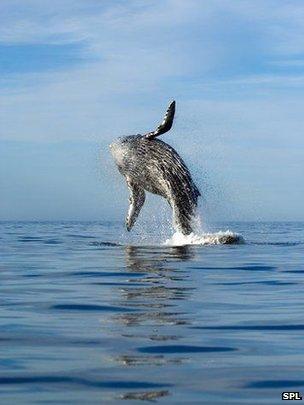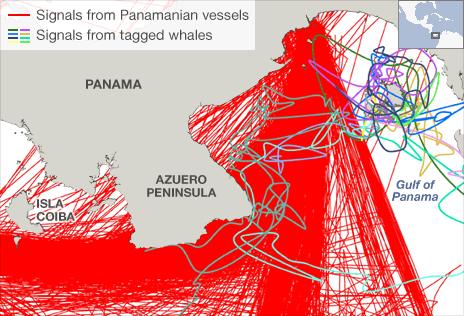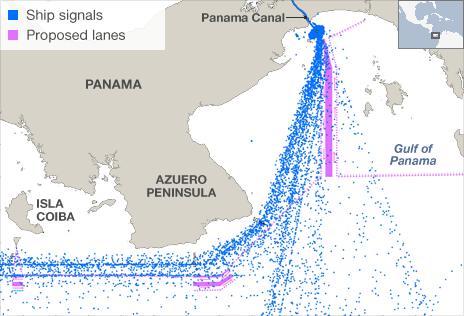Whales to gain Panama Canal traffic protection
- Published

Satellite-tagged humpbacks show just how often whales cross paths with ships
Shipping lanes into and out of the Panama Canal are likely to be constrained in order to protect whales.
Humpback whales breed around Las Perlas archipelago 60km (40 miles) from the canal's southern entrance, and are disturbed and even killed by shipping.
Panamanian officials and scientists have developed a plan that would corral vessels into narrow lanes.
They plan to present it for discussion and maybe adoption by the International Maritime Organisation (IMO) next year.
Details of the proposal were presented at the <link> <caption>International Whaling Commission (IWC) annual meeting</caption> <url href="http://iwcoffice.org/meetings/meeting2012.htm" platform="highweb"/> </link> in Panama City.
Hector Guzman from the Smithsonian Tropical Research Institute drew up the plans following research comparing movements of ships with those of 15 humpback whales fitted with satellite tags.
Maps show the whales swimming throughout the Gulf of Panama, which lies outside the canal entrance on the Pacific Ocean side, repeatedly crossing the ships' tracks.
"We recorded 98 interactions between whales and ships during an 11-day period," he told BBC News.
"Just over half of the whales had encounters; one particular whale had 45 encounters in just four days."
An "interaction" was defined as approaching within a distance of 200m - though the area has seen 13 whale deaths in the last two and a half years, some of which were probably as a result of being hit by a ship.
Watching brief
Humpbacks migrate northwards from their summer feeding grounds around Antarctica, arriving in the region around late June.
They breed in the fertile Las Perlas waters, where an upwelling of nutrient-rich water produces an annual plankton bloom.
Altogether, about 900 animals are thought to be involved. There are also visitors from a Northern Hemisphere humpback population.
Some 17,000 large ships pass through Panamanian waters each year, the majority international cargo vessels using the canal.
Data shows one particular vessel routinely passing right through the Las Perlas protected area in order to excavate sand from the sea bed and bring it to land for construction.

Las Perlas is becoming an important area for tourists, with whale-watching trips one of the attractions on offer.
Tomas Guardia, director-general for international organisations with the Ministry of Foreign Affairs and Panama's commissioner to the IWC, said the changes were stimulated both by economic factors and a burgeoning environmental awareness.
"The New York Times <link> <caption>selected Panama as their number one tourist destination for 2012</caption> <url href="http://travel.nytimes.com/2012/01/08/travel/45-places-to-go-in-2012.html" platform="highweb"/> </link> ; so when you add on an additional activity such as whale-watching, it all helps to promote Panama outside the country," he said.
"Also, many Panamanians were previously not aware of the resource we have close to our city, and in fact one of the reasons for hosting the IWC was to raise awareness of our marine environment."
Channel solutions
The government proposes funnelling ships into parallel lanes 65 nautical miles long, one approaching the canal entrance and one leaving it, separated by distance of about 2-3 nautical miles.
Dr Guzman calculates this would reduce the total area of sea where the whales would be at risk of collision by about 95%.
During the whale breeding season, ships would also be obliged to slow down to 10 knots on their way in and out.

Similar schemes have been implemented in several US ports, and the IMO has produced an advisory booklet based on the US experiences.
Vessels travelling west along the coast would be constrained into a couple of further corridor sections.
This would push them further offshore than they currently tend to travel, reducing the chance of collision with fishing boats.
"You can imagine; you have these small artisanal fishing boats and these huge vessels - it's just chaos, the way they come in and out of the country," said Dr Guzman.
"So [under the new scheme] they'll have their vessels, they'll be apart from the heavy traffic lanes - more important still is we're increasing the buffer of protection between the mainland and the shipping lanes in a region where we have five different protected areas including World Heritage Sites."
On the northern side of the country on the Atlantic Ocean side, where there is no significant presence of whales, the government is proposing a system involving three separate corridors leading in different directions.
Panama took over ownership of the canal from the US in 1999. The lock system is currently being upgraded, which will see vessels larger than the current 300m-long limit able to pass through.
Follow Richard <link> <caption>on Twitter</caption> <url href="http://twitter.com/#!/BBCRBlack" platform="highweb"/> </link>
- Published4 July 2012
- Published3 July 2012
- Published3 July 2012
- Published2 July 2012
- Published2 July 2012